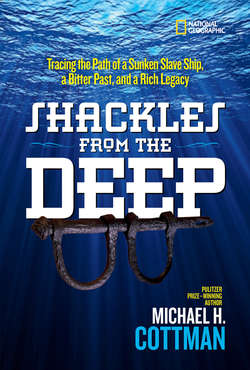Читать книгу Shackles From the Deep: Tracing the Path of a Sunken Slave Ship, a Bitter Past, and a Rich Legacy - Michael Cottman - Страница 12
CHAPTER 1
Оглавление
Instruction in youth is like engraving in stone. ∼ Moroccan proverb
I ZIP
UP MY
WET SUIT, adjust my mask, strap on my steel scuba tanks, breathe into my regulator, and slowly descend into a vast underwater world of translucent jellyfish, wide-winged manta rays, and giant sea turtles.
The gentle underwater currents nudge me along the colorful reefs—past the deep purple sea fans, the bursting orange coral heads, and the white tubular anemones that sway in the sea silt.
Bright yellow angelfish swim a few feet above me in synchronized rhythm.
Nearby, a shiny barracuda crosses my path with a snapped fishing line dangling from his mouth. He had no doubt stripped the bait from an unsuspecting fisherman and fled quickly into the deep.
In the distance, I watch the ocean’s most feared predators zig-zagging in and out of the shadows—the saw-toothed blacktip sharks that are more interested in observing the bubble-breathing scuba divers than confronting them.
I exhale and drop slowly to the sandy ocean floor.
I am a deep-sea scuba diver.
My love of the sea started when I was young. I grew up in a mostly black, middle-class neighborhood in Detroit, Michigan. In the evenings, I would sit in the living room watching Sea Hunt, an underwater adventure television program that aired when I was a boy in the late 1950s and early ’60s.
I enjoyed Sea Hunt because it was unlike anything I had ever seen. It featured ocean exploration and sunken ships and treasure—and I decided right then that I too would one day explore shipwrecks in distant oceans.
There was just one problem. Little boys from Detroit didn’t know much about scuba diving.
I was the only kid in my neighborhood who talked about diving, and I never missed an episode of this television show. My friends played basketball, football, and baseball. I enjoyed playing sports, too, but I yearned for travel and adventure.
For me, Sea Hunt was an escape of sorts, something to help me cope with the atmosphere surrounding the violent civil rights marches and demonstrations that were happening in Detroit at the time.
I didn’t know how to swim, but luckily my mother was not only supportive, she was also an excellent swimmer. She took me to the local pool and, in the protective shallow end, she taught me the “front crawl” and the breaststroke. Eventually she felt I was ready to master the deep end of the pool. I wasn’t so sure.
As I stood tentatively at the edge of the pool, looking into 10 terrifying feet of water, without warning, she pushed me in! I wish I could say that I swam around the pool with the grace of a delicate swan, but no—I sputtered and flailed to the side of the pool and clutched the cold tile as if it were a lifeline, gaping up at my mom and her sly smile.
But then, once my heart stopped racing, I looked back at the water and took a deep breath. I slipped under the surface and swam the entire length of the pool for the very first time. My mom told me how proud she was, and we drove home laughing about my first experience in the deep.
I’ve been swimming ever since.
This is a story about how my love of swimming, and later deep-sea diving, led me on a journey to three continents as I helped uncover the mystery surrounding a little-known 17th-century shipwreck. It’s about how I, along with others, pieced together a 300-year-old transatlantic puzzle that would teach me about myself—and where I came from. But more than that, it’s the untold story of millions of African people taken as captives to the New World, whose names and faces have been erased and eradicated by time, distance, and history.
